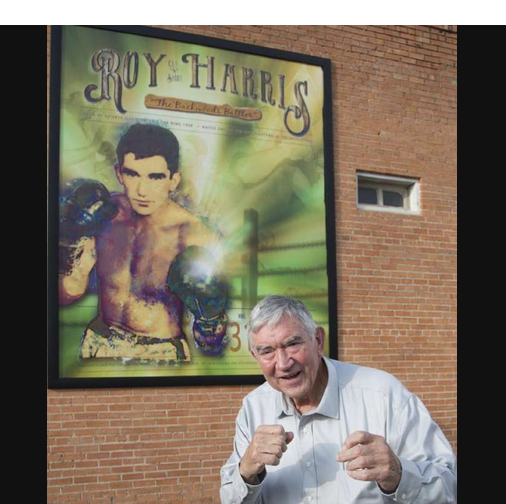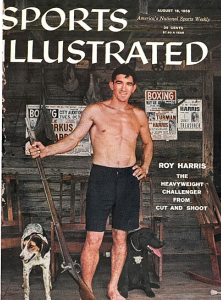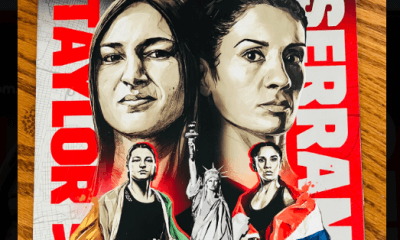Featured Articles
Remembering Roy Harris, the Boxer from Cut and Shoot Who Fought Floyd Patterson

Former world heavyweight title challenger Roy Harris passed away last week at the age of 90. This coming Friday, August 18, marks the sixty-fifth anniversary of the fight between Harris and the incumbent champion, Floyd Patterson, one of the quirkiest promotions in the history of fistiana.
Patterson vs Harris was a great triumph for the vendors of hucksterism. It was plain to anyone with a discerning eye that Roy Harris had no business in the same ring with Floyd Patterson — when the match was terminated, Patterson was ahead by 20 points (!) on one of the scorecards – but the promotion yet turned a handsome profit.
Roy Harris hailed from Cut and Shoot, a hamlet in southeast Texas on the edge of the Big Thicket. That imbued him with a ready-made hook. A publicist could concoct a heady brew from that place name alone and Roy “Cut and Shoot” Harris was fermented into a backwoods hillbilly in the mold of the comic book character L’il Abner. There was a fly in the ointment, however. Harris was an elementary school teacher with a college degree, but this fact seldom crept into stories about him as it animated the spoilsports. (The sports editor of an Indiana paper opined that Harris would have a better chance of overcoming Patterson “if he were, say, an unemployed artichoke picker who never finished the eighth grade.”)
As part of the pre-fight hoopla, Harris appeared on the cover of Sports Illustrated. Shirtless and barefoot, holding an old hunting rifle, he is flanked by his hound dogs. Back in those days, getting one’s face on the cover of Sports Illustrated, which sold for 25 cents on newsstands (remember newsstands?), was the crème-de-la-crème of pre-fight hype.

The accompanying story by Joe David Brown was full of fanciful fluff. It was actually true that Roy Harris practiced his craft in his backyard in a makeshift ring with barbed wire on one side and an occasional feral pig wandering about, but one must take with a grain of salt the assertion that whenever he ran out of sparring partners, his brothers would go out and shanghai barflys from local honky-tonks.
To be certain, the legend of Roy “Cut and Shoot” Harris was growing before he made the cover of S.I. As an amateur, he often fought barefoot. His father, Henry Harris – Big Henry to the locals – worked his corner wearing a coonskin hat.
Big Henry was no slouch when things got feisty. According to author Brown, he once ax-handled 16 people to the hospital during a disagreement at a local dance hall. Talking to a UPI reporter, one of Roy Harris’s brothers asserted that his uncle Bob, Big Henry’s sibling, once cut off a fellow’s head with a pocket knife. “In self-defense, of course,” he added, lest anyone get the wrong idea.
Down in southeast Texas, one didn’t mess with the Harris clan, but Roy Harris’s press clippings were of no use to him when he locked horns with Floyd Patterson on a Monday evening on a balmy 1958 night in Los Angeles. He had a moment of glory in the second round when he caught Patterson off-balance and scored a flash knockdown, but otherwise it was all Patterson who knocked Harris to the canvas in the seventh round and twice in the eighth and once more in the 12th before Harris’s cornermen insisted that Roy call it a night. At the finish, Floyd was unmarked and Roy was a bloody mess.
The “10-point-must” system was then fairly new in California and there was no consensus as to how to score a lopsided round. Referee Mushy Callahan scored round seven 10-6 and round eight 10-5. His scorecard favoring Patterson heading into the aborted rounds was the widest, but not by much. The judges had it 117-98 and 116-102.
The fight drew an announced crowd of 21,680 including many out-of-towners wearing 10-gallon hats. Perhaps another 200,000 witnessed the mismatch on a big screen. Patterson vs Harris was beamed to 151 closed-circuit outlets in 133 cities in the United States and Canada including eight locations in Texas. The tub-thumpers did their job well. Everyone made money.
In defense of Roy Harris, although he lacked a big punch, he could fight more than a little. His breakout year came in 1957 when he advanced his record to 22-0 with narrow decisions over Bob Baker and Willie Pastrano and a one-sided decision over journeyman Willi Besmanoff. Roy Harris was only a cruiserweight by today’s standards and Baker, a rugged campaigner from Pittsburgh, out-weighed him by 26 pounds.
His win over Willie Pastrano would take on a brighter tint when Pastrano wrested the light heavyweight title from Harold Johnson (a gift decision, but that’s a story for another day). The Harris-Pastrano fight had a rematch clause that stipulated that if Pastrano lost, Harris was obligated to fight him again within 60 days in Miami Beach where Pastrano, an Angelo Dundee disciple, then hung his hat. The rematch was postponed twice before dying on the vine. Harris had never fought outside Texas before meeting Floyd Patterson.
Whatever his limitations, Harris had a bottomless well of courage as he showed when he stayed 12 rounds with Patterson and again when he accepted a match with petrifying Sonny Liston who blasted him out in the opening round.
In retirement, Roy Harris quit school teaching after earning a law degree from the University of Arkansas. He sold real estate on the side and reportedly cashed in big as Cut and Shoot and neighboring, oil-rich Conroe grew in leaps and bounds. In 1966, he was elected County Clerk and served for 28 years. For someone painted as a backwoods hillbilly, he had quite a life.
Harris passed away peacefully on Aug. 8. A widower for the last 15 years of his life, he is survived by six children, nine grandchildren, and one great-grandchild. We here at TSS send our condolences to his loved ones.
—
Note: Joe David Brown’s Sports Illustrated cover story on Roy Harris is a real hoot. For some unfathomable reason, it was expunged from the Sports Illustrated vault. Brown, who passed away at age 60 at his home in rural Georgia, is best known for his novel “Addie Pray” which was fashioned into the 1973 blockbuster “Paper Moon,” a comedy starring Ryan O’Neal and his real-life daughter Tatum O’Neal, an Oscar winner at the age of 10.
To comment on this story in the Fight Forum CLICK HERE
-

 Featured Articles4 weeks ago
Featured Articles4 weeks agoAvila Perspective, Chap. 330: Matchroom in New York plus the Latest on Canelo-Crawford
-

 Featured Articles3 weeks ago
Featured Articles3 weeks agoVito Mielnicki Jr Whitewashes Kamil Gardzielik Before the Home Folks in Newark
-

 Featured Articles24 hours ago
Featured Articles24 hours agoResults and Recaps from New York Where Taylor Edged Serrano Once Again
-

 Featured Articles4 weeks ago
Featured Articles4 weeks agoCatching Up with Clay Moyle Who Talks About His Massive Collection of Boxing Books
-

 Featured Articles5 days ago
Featured Articles5 days agoFrom a Sympathetic Figure to a Pariah: The Travails of Julio Cesar Chavez Jr
-

 Featured Articles3 weeks ago
Featured Articles3 weeks agoMore Medals for Hawaii’s Patricio Family at the USA Boxing Summer Festival
-

 Featured Articles1 week ago
Featured Articles1 week agoCatterall vs Eubank Ends Prematurely; Catterall Wins a Technical Decision
-

 Featured Articles4 weeks ago
Featured Articles4 weeks agoRichardson Hitchins Batters and Stops George Kambosos at Madison Square Garden





















